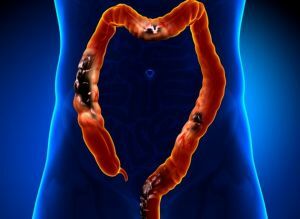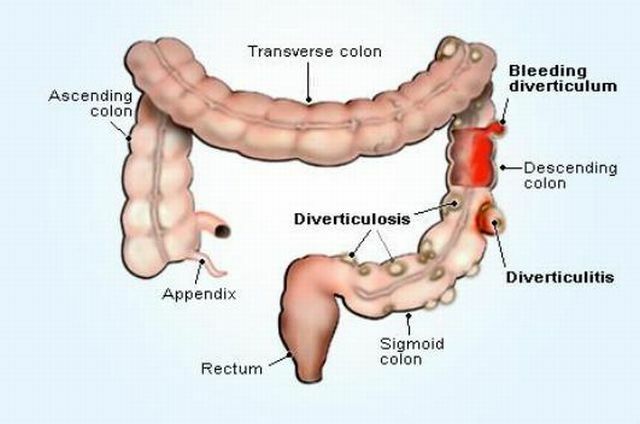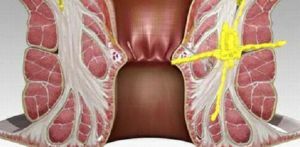 Diverticulosis of the sigmoid colon is one of the chronic diseases of the intestine, namely the sigmoid division. It manifests itself in the form of saccular hernias - diverticulum, formed on intestinal walls.
Diverticulosis of the sigmoid colon is one of the chronic diseases of the intestine, namely the sigmoid division. It manifests itself in the form of saccular hernias - diverticulum, formed on intestinal walls.
The disease occurs in one of ten people who have reached the age of forty. It quickly passes into a chronic form and by seventy years diverticulosis can be found in half of the population.
It should be noted that the disease spreads most in countries where the basis of the diet is products of animal origin. In countries with traditional vegetarianism, the percentage of cases is much lower.
Contents
- What causes the violation?
- Classification of the disease
- Features of the clinical picture
- Diagnostic methods
- Features of the therapy - goals and methods
- Surgical treatment
- Application of alternative medicine
- Possible complications
- Prevention of the disease
What causes the disorder?
The disease occurs due to the death of nerve fibers that connect the intestines with the brain, and a malnutrition. This leads to the thinning of local areas on the mucosa of the size of 1-2 cm.
With the movement of stools, thin sections can not withstand pressure and bulge outward to form diverticula. In some cases, they can appear throughout the large intestine. The emergence of a large number of neoplasms was called diverticulosis.
Factors of the development of the disease:
- development of atherosclerosis affecting the vessels of the intestine;
- occurrence of scars on the muscular wall of the intestine after chronic colitis and enterocolitis;
- dysbiosis;

- flatulence;
- various types of chronic constipation;
- genetic predisposition;
- lack of plant food in the diet;
- age after 50 years.
Classification of the disease
Diverticulosis, like many other diseases, are congenital and acquired.
The latter arise due to mechanical damage to the intestine, inflammatory diseases or abdominal pathologies( adhesive process).
Diverticulosis can be:
- is asymptomatic;
- with pronounced symptoms;
- complicated.
The complications of the disease include the following:
- acute or chronic form of diverticulitis;
- perforation( rupture) of the diverticulum;
- Intestinal bleeding;
- an obstruction of an intestine.
Features of clinical picture
At the initial stage of diverticulosis of the sigmoid colon for a long time is asymptomatic. 
The presence of the disease can be suspected if the following symptoms are observed for a long time:
- severity and dull pain in the lower left part of the abdomen, disappearing after excrement;
- bloating on the left side;
- chronic constipation.
The presence of these symptoms is a sufficient reason for going to the doctor and further examination.
Diagnostic methods
In the diagnosis of diverticular disease of the sigmoid colon, first of all, it is necessary to pay attention to the patient's complaints, lifestyle, diet and regularity of the stool.
An accurate diagnosis can be made using instrumental survey methods:
- Irrigoscopy is performed on an outpatient basis by inserting a contrast agent into the intestine and fixing with an X-ray machine. Special composition, delaying X-rays, is introduced into the intestine. The X-ray apparatus makes several photographs, by which the movement of contrast is monitored and the existing diverticula filled with it. As a result, the images will show the entire sigmoid colon, the presence and size of protrusions.
- Colonoscopy allows you to conduct a visual examination of the intestine. To do this, use a colonoscope - a special thin long probe with a video camera. The resulting image is transferred to the monitor. The probe consists of several channels, which can be used to introduce special instruments, carry out diagnostics or treatment( taking tissue for biopsy, removing polyps, cauterizing bleeding or eroding, etc.).The colonoscope is inserted into the anus and gradually moves the probe into the intestine. On the monitor, there will be openings of diverticula in the wall, foci of inflammation and places with poor permeability.
- In difficult cases, the patient may undergo an CT or MRI scan of the .

Therapy features - goals and methods
The purpose of treatment depends on:
- the state of the patient's body, its diet and lifestyle;
- disease stage;
- possible complications.
 Treatment of an easy stage of sigmoid diverticulosis reduces to the appointment of a diet based on a large amount of plant foods with a high fiber content. The daily dose of fiber is 30-35 grams.
Treatment of an easy stage of sigmoid diverticulosis reduces to the appointment of a diet based on a large amount of plant foods with a high fiber content. The daily dose of fiber is 30-35 grams.
With its lack, you can buy special nutritional supplements. The amount of liquid consumed should not be less than 1.5-2 liters per day.
The presence of an inflammatory process requires treatment in a clinical setting. It includes:
- compliance with the vegetative diet and drinking regimen ;
- use of broad-spectrum antibiotics i( aminoglycosides, penicillins, cephalosporins);
- prokinetics - stimulants of intestinal motility;
- antispasmodics - drugs that relieve muscle spasms;
- laxatives .
If therapy does not yield positive results for several days and additional complications arise, the patient is recommended hospital treatment and development of new tactics, including correction of early appointments, addition of infusion therapy and surgical intervention( removal of the affected bowel area).
Surgical treatment
As a reason for surgical intervention, there are two types of indications - emergency and planned.
The following apply to the emergency:
- diverticulum perforation;
- profuse bleeding;
- intestinal obstruction.
From planned it is possible to name:
- absence of result from treatment of disease by conservative methods;
- presence of fistula;
- formation of chronic infiltrate.
In most cases, instead of severe cavity surgery, the intervention is performed by a laparoscopic method. Instead of a long long healing suture, several punctures remain on the skin of the abdomen and a small incision is made to remove the removed part of the intestine. This allows patients to be discharged without complications for 3-5 days.
The use of alternative medicine
Treatment of diverticulosis of the sigmoid colon with folk remedies is used in conjunction with traditional medicines, and not instead of medical treatment and surgical intervention and under the supervision of the attending physician.
Good results are obtained with flaxseed or olive oil. They normalize the work of the intestines and relieve inflammation. One clove of garlic a day will help restore the microflora.
You can use a decoction from the bark of a rusty elm. For its preparation, take 1 tsp.bark and 0.5 tsp.powder from the bark of this tree for 1 glass of water. The broth is cooked for 20 minutes over low heat. Drink before meals 1-3 times a day for a glass.
Admission for a month infusion of fennel seeds, rose hips, chamomile flowers, motherwort leaves and nettles will increase immunity, relieve inflammation and reduce the formation of gases. To get the infusion it is necessary to mix all the ingredients in equal parts, take 1 tbsp.mix and pour in a thermos glass with 1 glass of warm water. Grass is infused for 1.5 hours, after which it should be taken 1/2 cup twice a day.
Possible complications of
With the development of inflammation in the wall of the intestine( diverticulitis), the symptoms change - the pains become prolonged( up to several days) and localized in a certain area.
The temperature rises to 40 degrees, there is nausea and vomiting, swelling of the intestines, constipation and diarrhea are observed. The rupture of the inflamed intestine with the ingestion of the contents into the abdominal cavity leads to peritonitis.
If the ulcer formed in the diverticulum affects the vessel located there, intestinal bleeding may develop. The amount of blood in feces depends on the size of the affected vessel. Chronic bleeding leads to the development of anemia.
A purulent abscess often forms in the cavity of the diverticulum. If the burst is broken inside the intestine, the patient may recover. If the abscess breaks into the organ with which spikes have formed, then an internal fistula( an opening connecting the two organs) arises. 
The most common fistulas are of three types:
- gastrointestinal , accompanied by frequent vomiting with an admixture of feces in the vomit;
- intestinal-vaginal , accompanied by abundant secretions with feces and an unpleasant odor;
- Esophageal , which cause chronic cystitis, is distinguished by the excreting particles of faeces, pus and gas bubbles during urination, which occurs mainly in men.
A commissural disease that develops from diverticulitis can lead to intestinal obstruction.
Prevention of the disease
As preventive measures it is possible to recommend:
- to change the way of life to a more active one;
- closely monitor your health and promptly consult a doctor;
- increase the number of fruits and vegetables in the diet.
Diverticulosis of the sigmoid colon as well as most diseases of modern man is associated with a sedentary lifestyle, the presence in the diet of heavy fatty foods and bad habits.
Therefore, if there is no desire in old age to contact doctors with this unpleasant disease, it is worth thinking about this much earlier. Prophylaxis of the disease is useful and pleasant - more vegetables and fruits in the diet, adherence to the diet and exercise with inactive work.
